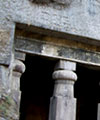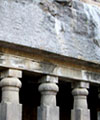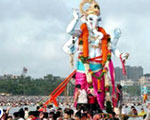|
Pune
Places to Visit
[ Lonauli | Khed Taluka | Maval Taluka | Mulshi Taluka | Shirpur | Vadhu - Tulapur | Ambegaon | Baramati | Bhor Taluka | Daund | Indapur Taluka ]
Lonauli
Lonauli is a small town in the Pune District of Maharashtra state, India.
Location co-ordinates for Lonauli are 1845.000N, 07325.000E and is situated at the altitude of 2047 ft. The town is at the mouth of Borghat Pass, which is used to cross the Western Ghats on the travel from Mumbai to Pune.
During the British Raj, Lonauli was being recommended as a place of resort from Mumbai during the hot season.
Top
Khed Taluka
In the Taluka Khed, is a place called Rajguru Nagar which is named after the freedom fighter Rajguru who lived here. The big Wild Life Sanctuary of Pune district which is in Bhimashankar falls in this region. Collection of Honey, Wax, Gum and other Medicinal Herbs are some of occupations carried out in this area. The farmers here basically grow the crops like Bajara and Jawari and Vegetables like Tomato, Potato, Onion is also grown. Oil refinenary are also found in this area. Tribal people are commonly found in this region. In Chakan there is the famous fort of Bhuikot. The Memorial of Sambaji is in Vadu (Tullapur).
Top
Maval Taluka
Maval is towards the west of Pune District. It receives heavy rainfall. This is the hilly area of Pune, with one of the biggest range of mountains in Maharashtra i.e. Sahyadri Mountain. The Hill Stations like Lonavala and Khandala are in Maval where tourists are mostly attracted in the rainy season. Most of the area is covered with Forest. Sag, Teak, Oak, Mango, are the trees found in the forest. Rabbit, Deer, Wolf, Fox, Tiger and Leopards are the wild animals found in the forest of this area. Peacock, Bulbul, Parrot are some of the birds which you can see here. Rice is commonly grown. There is a Glass factory in Talegaon.
Top
Mulshi Taluka
Mulshi Taluka falls to the west of Pune. This area receives heavy rainfall. It is the hilly region of Pune, with one of the biggest mountain ranges in Maharashtra i.e. Sahyadri. Most of the area is covered with Forest. Sag, Teak, Oak, Mango, are the trees found in the forest. Rabbit, Deer, Wolf, Fox, Tiger and Leopards are the wild animals found in this areas. Peacock, Bulbul, Parrot are some of the birds found in this area. Rice is grown in this region. Rice named Kamod is grown here on a large scale. There is also a dam in this Taluka.
Mulshi (A good Picnic Spot) Mulshi is to the west of Pune and close to Lonavala as well as Konkan region. Mulshi dam and the surroundings are full of natural beauties that includes a dam, hilly region of Sahyadri's deep forests and forts like Dhangad and Koraigadh. Water of Mulshi is used for generating electricity. It is one of the major electricity project in Maharashtra. The beauty of Mulshi lake can be observed from 'Valanewadi' - 6 Kms. from Mulshi. Sahyadri is famous for its deadly hills and its beauty. Both the things can be observed here. The hills of Ratnagiri and hill ranges of 'Hattihant' and 'Pagota' are huge ones and terrific. Some of these hills are almost 4000 feet high. There is one platue here popularly known as 'Lavmal'. Mulshi is very near to Pune and a short trip here can be arranged. One must enjoy the marvelous lake, the dam, forest and hilly region of Mulshi. If you are lucky then you can enjoy boating here as well. Thus, it is a newly developing picnic spot near Pune. One of the newly attractive picnic spot developed in resent times. These spot has all the things what a visitor would like to see & enjoy. The place is very near from Pune. It is towards the west of Pune.
The small village mulshi falls in maval taluka has all the natural beauties which attracts the visitor. It has mulshi dam, A lake named 'Valanewadi' which is just 5 Kms from mulshi, if you are lucky you can even enjoy boating here. As these village falls into Sahyadri region it also has deep forests with marvelous forts like Dhangad & Korigadh. Besides these the place is also famous for its mountains (it is believed that these are the strongest mountains) & a platue named "Lavmal". The hills named Hattihant, Pagota are amazing to see which reaches to the height of almost 1000 mts high.
Above all Mulshi is more famous for its dam which is the major dam which generates electricity for maharashtra. People visit these place in every rainy season in large amount to enjoy the nature which is not found in today's cities.
You can reach the place by road through, S. T. buses which covers all the spots.
So if you are looking to arrange a small picnic or wants to be near to loved ones these place is unique one for you . So over all the spot is total paise vasool spot.
The best time to visit these place is in rainy season.
Top
Shirpur
In Shirur you will find hot temperature and scanty rainfall. The land here is suitable for growing Crops like Wheat and Sugarcane. Fruits like Oranges and Sweet lime are also grown.
Top
Vadhu-Tulapur
(Samadhi of Chatrapatti Shabhaji Raje)
Vadhu and Tulapur are the places related with Sambhaji - the son of Shivaji Maharaj. Sambhaji was killed in Tulapur and his samadhi was built in Vadhu. Thus, both these places are historically very important. Tulapur is situated on the banks of 3 rivers- Bhima, Bhama and Indrayani. It is famous for the temple of Lord Shiva. In this temple - known as Sangameshwar, Sambhaji was arrested by Aurangzeb and was later killed. Tulapur was originally known as ' Nagargaon'. A small temple here is very beautiful and must see. And next to the temple, the samadhi of Sambhaji Maharaj is built. Really a place where we can remember the famous Maratha. Vadhu is very near from Tulapur where the dead body of Sambhaji Maharaj was brought and then was cremated. So you can see the samadhi at both the places. An idol of Sambhaji Maharaj was put up in 1977 in Vadhu.
Top
Ambegoan
It covers the area from Bhimashankar to Lakhanpur. This taluka has survived with the blessings of Kulguru Shree Khanderaiya of Bhimashankar. Agriculture is the main occupation of this region. The most commonly grown crop is Bajara and vegetables like Potato, Tomato are also grown and fruits like Grapes, Banana, Tomato and Potato are grown. There are Oil refinenaries in this region. Adavasi Tribes are found in large number in this region.
This Taluka falls to the foothill of Sahyadri Mountain range and which is towards the west side of Pune city. This taluka gets divided into two parts i.e. north and south because of the Pune Nasik highway which passes through this area. In the north the degree of rainfall is very low therefore the area is dry and on the contrary in south the rainfall is heavy and the area is also hilly. In north wheat, jawari and bajari are most commonly grown crops where as in south rice is grown. Trees like Sag, Teak, Oak, Mango, are found in these forests. Animals like Rabbit, Deer, Wolf, Fox, Tiger and Leopards are found here and the birds like Peacock, Bulbul, Parrot mostly occur in these forest.
Besides this the dairy business is also carried out on large scale. Rivers like Ghod and Dhimbe provide water for cultivation. The farmers have made their own image on the basis of their hard work. Bullock cart races are an inseparable part of this taluka which is very prominent throughout Maharashtra. Janta Utsav is the famous festival of this area while other functions for yatra, wrestling, Tamasha and numerous religious programmes are held by various Mandals. Ganesh utsav, Navratra utsav etc are also celebrated with great enthusiasm. Dhimbe dam is also there. The height of the dam is about 100 meters and the capacity is 13.5 (T.M.C). Recently a new sugar factory has been constructed in Bhimashankar. The famous temple of Bhimashankar is in this taluka.
Top
Baramati
Baramati receives scanty rainfall. The temperature over here is hot. Shirsufal lake is in this region. Wheat and Jawari , sugarcane are grown here on a large scale. Grapes are also grown here in n here in abundance. Many Sugar factories are been set up in this area. There is a huge Market place for cotton and food grains. Mr. Sharad Pawar the very famous politician comes from Baramati.
Top
Bhor Taluka
Bhor Taluka receives heavy rainfall. This is a hilly region and is towards the west of Pune, with one of the biggest of mountain ranges in Maharashtra i.e. Sahyadri Mountain ranges. Most of the area is covered with forest. Sag, Teak, Oak, Mango, are the trees found in these forests. Rabbit, Deer, Wolf, Fox, Tiger and Leopards are the wild animals found in this area. Peacock, Bulbul, Parrot are some of the birds found in this area. Crops like Rice and Jawari are grown in this region and the most commonly grown rice which is called Ambemohar. There is a Paper Mill in Sarole. Rexane, Mosquito net, Soot cloth, Sugar Factory, Paint factories are also found here. The famous picnic spot Baneshwar is in this Taluka.
Top
Daund
The Geography :
One of the main talukas towards the Eastern side of Pune is Daund. East to West Distance of Daund is 75 kms and breath wise Daund is 45 kms wide. The total area of the Taluka is 1290 sq. kms.Daund taluka comprises of 65 villages. Bhima, Mula and Mutha are the three rivers in Daund. Average Rainfall over here is 350 to 375 m.m.
Daund In Ancient Times :
In ancient times 'Dhaumya Rishi' used to stay in this place, hence people started calling this place after his name as 'Dhaum'. As the times passed 'Dhaum' became 'Dhoand', then 'Dhaundh', and as the time passed it got its name is 'Daund'.
According to the Epic Mahabharata Shri Krishna's wife Rukhmini had gone in the 'Dhindir forest', this ancient 'Dhindir Van' is todays Daund.Shri Vitthal's statue with black statues of both Rahi and Rukhmini on the either sides is the only Vitthal Temple. Because of the hugeness of the temple it is also called as the 'Prati Pandharpur' (like a replica of Pandharpur).
Daund In Shivaji's Era :
Father of Shivaji Maharaj Shahaji Maharaj was a Sardar in the Nizam Shahi. He had got Daund and surrounding area as a 'Jagir'. In this Jagir there was an important fort called Bahadurgad in Pedgaon which is 13 kms from Daund. Bhadurgad is even today standing on the banks of the river Bhima. Bahadurgad is four times as big as that of Shaniwarwada. 9 kms away from Daund is a place called 'Kurkumb', there are temples of two Goddess - 'Tukai' and 'Firangai', Shavaji's father Shahaji Raje along with his family used to come here. Teacher of Shivaji, Dadoji Konddeo was from Daund Taluka and used to stay in 'Malthan'. The place where he resided can be seen even today.
Daund And The Peshwas :
In 1739 the Bajirao - Mastani affair had brought clashes among the Peshwa family, hence Bajirao Peshwa took Mastani away from Pune and made her stay in Patas. Hence forth Bajirao and Mastani met at the Firangai Devi temple in Kurkumb.Water of the rivers Bhima, Nira, Pravara, Ghod and Godavari are best suited to the horses, hence the horses breeding on these waters used to be strong, quick and loyal. The area of 'Bhimthadi' which is close to Daund was famous for getting good breed of Horses and people preferred to get a pony only from this place. This breed was supposed to be the best of all. Hence the Horse business in Daund has flourished.At the end of the Peshwa Era due to heavy loans on them Daund and some villages from Pune had gone in control of 'Girgosavi'.
Daund And The British :
Daund got very much developed during the British rule. When Railways were started during the British rule in 1870, the 'Bombay-Solapur' railway passed via Daund. In 1894 'Daund-Baramati' Meter Gauge route was started. Daund became a Junction after the 'Daund-Manmad' train. Daund got connected to Srigonda when in 1928 the bridge over river Bhima was constructed.In the British period Daund was an important center for the Coal Engines. There were more than 125 Coal Engines in Daund. for this Daund also had a big work shop in it. Because of this the ash of the coal was found in abundance. Hence the brick making business started and it went to various big cities.
3 kms away from Daund there was the Indian wireless center. At that time there only 2-3 wireless centers in India. From 1942 to 1945 two Military camps were set up in Daund.The first theater called 'Hind Cinema' was started in 1938, and the first hotel in Daund called 'Maharashtra Khanaval' was started in 1930 which owned by Mule and in 1940 the 'Jogalekar Upahar Gruh' came into existence.
More About Daund :
Daund is a Taluka with very hot temperature. This area receives scanty rainfall. Lakes like Warvand, Kasurdi and Motoba fall in this Taluka. Wheat and Sugarcane are grown over here. Fruits like Orange and Sweet Lime are grown here. You can also find flower gardens in this region. There is a Sugarcane factory in this Taluka. Main Occupation of the people in Daund is Farming. One can reach Daund by the means of (S.T)State Transport or by Train. There are Shuttles Running from Pune Station to Daund. The major stops taken by the shuttle are Hadapsar, Manjri Budruk, Loni, Urali Kanchan, Yavat, Kedgaon, Patas and then it reaches Daund.
The famous Freedom Fighter Late Shree Kisandas Gulabchand Kataria was from Daund. He was awarded with the degree of Natya Bhushan, Shikshan Maharshi and many more. Daund Station is a Railway Junction. Most of the trains pass through Daund Junction. There is the Old Railway bridge towards Nagar which was built by the British Government. The condition of bridge is very good even after a long period since it was built. Newly built bridge over river Bhima is also mind blowing. Some area of Kurkumbh in Daund is declared as Chemical Zone for the Chemical Industries. Most of the Industries from all over Maharashtra have been shifted to Kurkumbh.
The historical place in Daund is the Ancient Vitthal Temple, there are some more attractive Temples in Daund . There are 9 Masjids in Daund. The Norton Memorial Church and Christ Church are two main Churches, including 10 more Churches in Daund. There are also a few Gurudwaras in Daund. Narayan- Bet near Chaufula in Daund is a popular picnic spot. Firangai Mata Temple in Kurkumbh is one of the Ancient temples and a picnic spots just 7 Kms away from Daund. At Malthan which is at a distance of 22 Kms from Daund is the Palace of Dadoji Kondhdev, teacher of Shivaji Raje Bhosale. Ancient temple of Bhuleshwar is located at Yavat which is 15 Kms from Daund. Hind Cinema and Panchsheel are two Entertainment theaters in Daund.
Top
Indapur Taluka
Temperature of Indapur is hot. This area receives Scanty Rainfall. Shetfal lake is over here. Crops like Wheat, Jawari, Sugarcane are grown. There is a machinery factory in Walchand Nagar , Sugar factory and Iron factories are also here.
Top
Info. of Visit Places in Pune city of Maharashtra
- India
|






